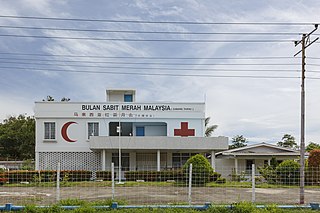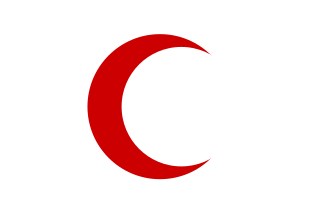
The Red Crescent Society of Turkmenistan was established in 1926 and it has its headquarters in Ashgabat, Turkmenistan.

The Red Crescent Society of Turkmenistan was established in 1926 and it has its headquarters in Ashgabat, Turkmenistan.

The International Red Cross and Red Crescent Movement is an international humanitarian movement with approximately 97 million volunteers, members and staff worldwide, which was founded to protect human life and health, to ensure respect for all human beings, and to prevent and alleviate human suffering. Within it there are three distinct organisations that are legally independent from each other, but are united within the movement through common basic principles, objectives, symbols, statutes and governing organisations.

The flag of Turkmenistan features a white crescent and five stars representing the five regions of the country. Placed upon a green field is a symbolic representation of the country's famous carpet industry. It was introduced as the flag of Turkmenistan on 27 September 1992 to replace the Soviet-era flag which consisted of a red background with two light blue bars in the middle. The modified version with a 2:3 ratio was adopted on 23 January 2001. State Flag and Constitution Day is celebrated on 18 May.
The British Red Cross Society is the United Kingdom body of the worldwide neutral and impartial humanitarian network the International Red Cross and Red Crescent Movement. The society was formed in 1870, and is a registered charity with more than 17,200 volunteers and 3,400 staff. At the heart of their work is providing help to people in crisis, both in the UK and overseas. The Red Cross is committed to helping people without discrimination, regardless of their ethnic origin, nationality, political beliefs or religion. Queen Elizabeth II is the patron of the society.

The emblems of the International Red Cross and Red Crescent Movement, under the Geneva Conventions, are to be placed on humanitarian and medical vehicles and buildings, and to be worn by medical personnel and others carrying out humanitarian work, to protect them from military attack on the battlefield. There are four such emblems, three of which are in use: the Red Cross, the Red Crescent, and the Red Crystal. The Red Lion and Sun is also a recognized emblem, but is no longer in use.

The State Emblem of Turkmenistan was created after Turkmenistan gained independence from the Soviet Union in 1991. Like other post-Soviet republics whose symbols do not predate the October Revolution, the current emblem retains some components of the Soviet one such as cotton, wheat and rug. The eight-point green starburst with golden edges features in its center a red circular disc which carries sheaves of wheat, five carpet guls, and centered upon that a smaller blue circle with a lifelike depiction of former President Saparmurat Niyazov's pet Akhal-Teke horse Yanardag, a source of pride for the Turkmen people. A round variant of the emblem was used from 1992 until 2003, when President Saparmurat Niyazov proposed to change its appearance and said that the ancient Turkmen octagon has been considered to be a symbol of abundance, peace and tranquility.

Turkish Red Crescent is the largest humanitarian organization in Turkey and is part of the International Red Cross and Red Crescent Movement.

The Malaysian Red Crescent Society (MRCS), is a voluntary humanitarian organization that seeks to promote humanitarian values, as well as provide service and public education in disaster management, as well as healthcare in the community. It is part of the International Red Cross and Red Crescent Movement.

The International Federation of Red Cross and Red Crescent Societies (IFRC) is a worldwide humanitarian aid organization that reaches 160 million people each year through its 192-member National Societies. It acts before, during and after disasters and health emergencies to meet the needs and improve the lives of vulnerable people. It does so with impartiality as to nationality, race, gender, religious beliefs, class and political opinions.
Pakistan Red Crescent Society is an organization that provides emergency medical and relief services for Pakistanis. The society was founded on 20 December, 1947 after Pakistan's independence by an order called The Pakistan Red Cross Order, led by Nurse Saloni Malik. It was later renamed the Red Crescent Society or the Red Crescent Order. Its headquarters are in Islamabad.

Bangladesh Red Crescent Society is a humanitarian organization and auxiliary to the Government of Bangladesh. The organization was established in 1973 as the Bangladesh Red Cross Society through the Presidents Order 26. It changed its name to Bangladesh Red Crescent Society in 1988 while the country adopted Islam as the constitutional religion. It has its headquarters in Dhaka and also have 68 branches. The society has played an instrumental role in relief and rehabilitation during floods, cyclones and other natural disasters which are frequent in various parts of Bangladesh.

Bahrain Red Crescent Society was established in 1971, via a charter issued by Sheikh Isa bin Salman Al Khalifa, the Amir of Bahrain at the time. The society was recognized by the International Federation of Red Cross and Red Crescent Societies on 14 September 1972. It is the 116th member of the international group since its inception in 1919. It has its headquarters in Hoora, Manama.
The Rome Consensus for a Humanitarian Drug Policy is a framework for dialogue and cooperation that commits 114 National Societies of Red Cross and Red Crescent from Africa, Asia, the Americas and Europe to promote and implement humanitarian approaches to drug policy. The Rome Consensus aims at raising the profile of drug policy to the forefront of social concerns, hinging formulation and implementation of drug control on public health concerns.
The society Lithuanian Red Cross, in Lithuanian Lietuvos Raudonasis kryžius, was founded in 1919. It was reestablished after the collapse of the Soviet Union. The Seimas, the Lithuanian parliament, passed a Red Cross law in 2000. The society has its headquarters in Vilnius, the capital of Lithuania.
The Red Crescent Society of the United Arab Emirates is the United Arab Emirates (UAE) affiliate of the International Federation of Red Cross and Red Crescent Societies. The authority was founded in Abu Dhabi in 1983 with support of the late Sheikh Zayed bin Sultan Al Nahyan. Its main objectives are to carry out Red Cross operations on a systematic basis throughout the UAE.

The North Cyprus Red Crescent Society is the Red Crescent society in the Turkish Republic of Northern Cyprus. A non-member of the International Red Cross and Red Crescent Movement.

The Indian Red Cross Society (IRCS) is a voluntary humanitarian organization to protect human life and health based in India. It is part of the International Red Cross and Red Crescent Movement and shares the Fundamental Principles of the International Red Cross and Red Crescent Movement. The society's mission is providing relief in times of disasters/emergencies and promoting health & care of vulnerable people and communities. It has a network of over 700 branches throughout India. The Society uses the Red Cross as an emblem in common with other international Red Cross societies. Volunteering has been at the very heart of the Indian Red Cross Society since its inception in 1920, with the Society having Youth and Junior volunteering programmes. The Society is closely associated with the St John Ambulance in India.
The Maldivian Red Crescent (MRC) is an independent, volunteer, non-profit, humanitarian organization established in the Maldives by virture of the Maldivian Red Crescent Act Law No: 7/2009

The Azerbaijan Red Crescent Society is the largest humanitarian organization in Azerbaijan and is part of the International Red Cross and Red Crescent Movement.
The Yemen Red Crescent Society is a Yemeni humanitarian association founded in 1968. The group is a national affiliate of the International Federation of Red Cross and Red Crescent Societies.